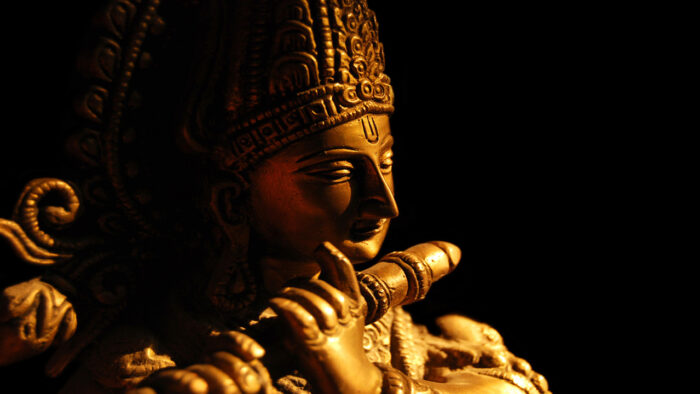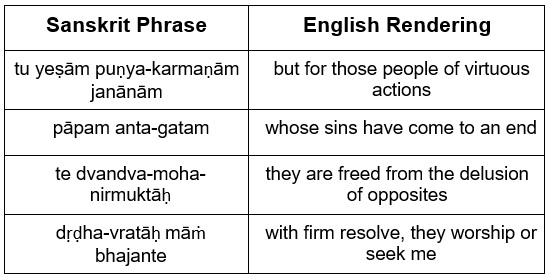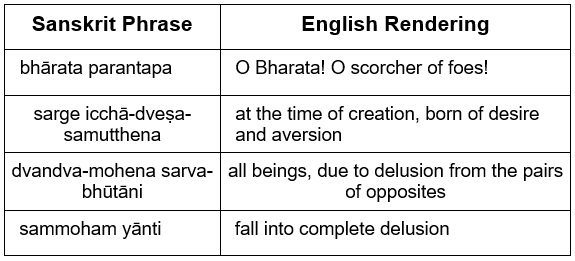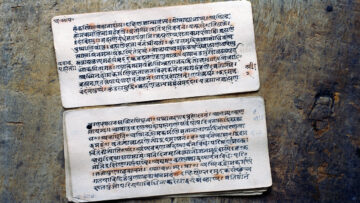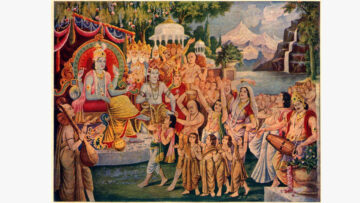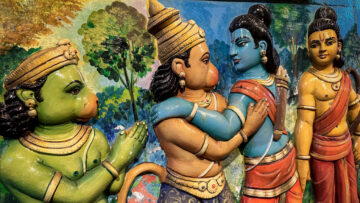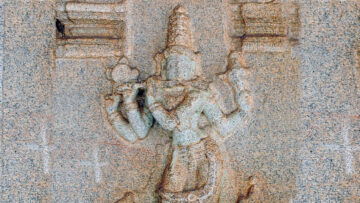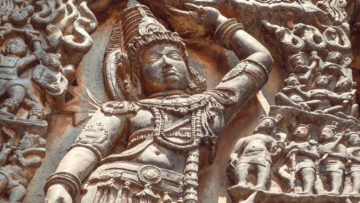A Contemplative Glimpse into Vedanta’s Heart
Creation is not the loss of truth, but the dance of appearance; where the self, though hidden, remains ever present and whole.
Introduction: The Riddle of Divine Design
Why would Śhrī Kṛiṣhṇa, who is full of love and wisdom, create a world where we forget who we truly are? Why would the soul enter into a life where it struggles, suffers, and keeps searching for something, only to one day realize that it had always been whole? This is not just a question for scholars or saints. It touches all of us, in quiet moments when life feels confusing or painful. It comes up when we wonder what all of this is really for.
Vedanta gently invites us to reflect on this. It does not ask us to figure it out like a puzzle. Instead, it encourages us to sit with the question, to feel it in our heart. The ancient teachings say that Brahman, the ultimate reality, is complete in itself. There is no emptiness in it. From that fullness, this world appears, just like waves rise from the sea. The ocean does not become less because a wave has formed. The wave too is made of the ocean. The Upanishads describe this with the verse, “pūrṇam adaḥ pūrṇam idam” — that fullness remains full even when it gives rise to another fullness. Nothing is lost in the appearance. Wholeness brings forth wholeness.
Yet we often feel separate, small, and unsure. We carry names, roles, and memories. We try to hold on to things, fix problems, chase meaning. And still, there is something within that whispers there must be more.
What if this forgetting is part of the journey? What if the very act of remembering brings something alive within us that was always there, just unseen? Maybe life is not a test or a trap, but a deep invitation to look again. Not with pressure, but with care.
This is where we begin. Not to solve anything, but to sit with the question. And slowly, something in us begins to listen.
Vedanta’s Vision of Creation: Overflow from Fullness
When we listen to the teachings of Vedanta, one of the first truths we come across is that Brahman is pūrṇa. That means complete, whole, and without any lack. Brahman is not a being or a force trying to become something. It is already full. It is self-aware, ever-present, and peaceful. It does not need to create, yet from this fullness, everything appears.
Creation, as Vedanta sees it, is not something built or made from outside. It is more like waves rising on the ocean. The wave looks different, it moves, it has a shape. But the wave is still the ocean. In the same way, what we call the world, or this life, is not something separate from Brahman. It is Brahman appearing in many forms.
But here comes something important. What we experience as the individual self is not the real self. What is created is not our true being, but only the sense of being limited. This sense comes from how we identify with body, mind, name, and memory. We start thinking, “This is who I am.” And slowly, we forget the deeper presence that always was.
Vedanta speaks of jīva, the individual who feels separate, and Ātman, the true self which is never separate. Ātman is not born. It is not touched by anything. But jīva feels small, incomplete, and confused. This confusion begins when awareness forgets itself and starts looking outward.
So when we ask what was created, the answer is not you in your deepest truth. What appears is a passing form, like a wave or a shadow. The self, your real self, was never missing. It only seemed covered. Vedanta invites us to look again, with quiet attention, and remember.
You Were Never Created: The Tender Truth of Sat-Chit-Ānanda
There is a gentle truth at the heart of Vedanta. It says that your real nature was never created. What you are, in the deepest sense, is not something that began in time. You are not a product of birth. You are not a bundle of thoughts and feelings. You are something much quieter and more constant.
The sages used three simple words to describe this nature: Sat. Chit. Ānanda. Each one points to something that is always present within you, even when life feels messy or confusing.
Sat means pure being. It is that sense that you exist, without needing proof. Before any idea, before any role, there is simply the fact that you are. This being does not come and go. It stays.
Chit means pure awareness. It is the light by which you know anything. Not just thinking, but the very ability to know. This awareness is not something you create. It is already there, quietly holding every moment.
Ānanda means peace, or bliss. Not the joy that comes from an achievement or a person. But the soft contentment that has no reason. It is the calm feeling that everything is okay, even if the mind cannot explain why.
These three are not outside you. They are you. Not your personality or your story, but the part of you that watches, rests, and remains.
Why don’t we feel this always? Because we get caught. We start to believe that the body is who we are. Or the mind. Or the memories. We look at the mirror or our thoughts and say, ‘This is me.’ Slowly, the real gets covered. It remains present, though it may feel forgotten at times.
The ego-self, the one that says, ‘I am this’ or ‘I want that,’ is just a surface layer. It is like a mask worn for a play. Useful in the moment, but not the real face. The body too, though precious, is not the full truth of who you are. The ancient teachings speak of Yogātmā puruṣa-viveka; the clear seeing that helps one recognize the difference between what is witnessed and the one who witnesses. This clarity grows over time, and with it, the sense of being returns to its true ground.
When we identify with the surface, we begin to feel separate. From others, from life, and even from our own peace. This is the start of the illusion.
Vedanta gently reminds us that what you are has never changed. The being, the knowing, the peace, are already present. You don’t have to build them. You only have to remember.
Māyā and Avidyā: The Art of Forgetting
One of the most tender insights in Vedanta is that the soul does not lose its truth. It simply forgets. This forgetting happens through two forces spoken of in the scriptures. One is called Māyā, which means appearance. The other is Avidyā, which means ignorance or not knowing.
Māyā is the power through which the world appears real and solid. It makes names, forms, roles, and identities feel fixed and important. It gives the feeling that we are separate, that we must chase, struggle, and prove. Māyā is not evil. It is a part of the play. It helps life move. But if we do not see through it, we begin to feel lost.
Avidyā is the not-knowing of who we truly are. It is like looking into a mirror and seeing only the reflection, not the surface that holds it. Over time, we forget the mirror. We fall in love with the image. We fear for it. We live for it. But the mirror was always there. It never left. We just stopped seeing it.
Śhrī Kṛiṣhṇa says in the Bhagavad Gita, verses 7.26 to 7.28, that He knows all beings. Past, present, and future are clear to Him. But those caught in desires and dualities cannot truly know Him. Only when a person becomes quiet inside, after many lives of effort, do they come to Him with steady love.
येषां त्वन्तगतं पापं जनानां पुण्यकर्मणाम् ।
ते द्वन्द्वमोहनिर्मुक्ता भजन्ते मां दृढव्रता:॥ ७.२८ ॥
yēṣāṁ tvantagataṁ pāpaṁ janānāṁ puṇyakarmaṇām |
tē dvandvamōhanirmuktā bhajantē māṁ dr̥ḍhavratāḥ ||7.28 ||
Semantic Analysis
English translation: “But those who have engaged in righteous actions over lifetimes and have exhausted their sins, being free from the confusion caused by dualities, approach Me with unwavering devotion and spiritual resolve.”
This ‘knowing’ is not something new. It is not a prize or a reward. It is a deep ‘remembering’. Like waking up from a dream and realizing you had always been safe.
Vedanta does not say you must become something. It gently says, you already are. You simply forgot. And now, with care and attention, you can begin to remember.
Metaphors That Illuminate the Truth
Stories and images can sometimes show what words alone cannot. In Vedanta, teachers often use simple metaphors to bring deep truths closer to the heart. These pictures help us see what cannot be touched or described easily. Let’s reflect on three such metaphors that quietly point back to who we truly are.
a) The Clay Pot and the Space Within
Imagine a clay pot. It has a shape, a name, and a use. You might call it a water pot or a flower pot. But what is inside it? Space. What is around it? Also space. The pot gives the feeling that there is a separate space inside, held apart from everything else.
Now imagine the pot breaks. What happens to the space inside? Nothing. The space was never truly held or limited by the pot. It only seemed so because of the walls.
In this metaphor, the pot is your body and mind. It is temporary, shaped for a time, and useful. But what you truly are is the space within. That space is your awareness, your presence. It was never born and never ends.
The Gita reminds us again and again that the Self is untouched by birth and death. It is not made of parts. It is not cut, burned, or broken. The walls may come and go, but what you are remains.
“Can I live more from that space, even as the pot moves through the world?”
b) The Dream and the Dreamer
At night, you lie down and fall asleep. In your dream, you may become someone else. You may travel, feel joy, feel fear, or face trouble. It all feels real while it lasts.
But then you wake up. And suddenly, that whole dream world vanishes. The person you thought you were was never real. The places, the people, the struggles, all came from your own mind. They were part of a story. You were always lying safely in your bed.
This is how Vedanta speaks about life. It says that we are like the dreamer who has forgotten that he is dreaming. We have taken on roles, beliefs, and emotions as if they are who we are. But Śhrī Kṛiṣhṇa quietly tells us in Gita 7.27 that all beings are born into a world shaped by dualities, desire, and aversion. That is the sleep.
इच्छाद्वेषसमुत्थेन द्वन्द्वमोहेन भारत ।
सर्वभूतानि सम्मोहं सर्गे यान्ति परन्तप ॥ ७.२७ ॥
icchādvēṣasamutthēna dvandvamōhēna bhārata |
sarvabhūtāni saṁmōhaṁ sargē yānti parantapa || 7.27 ||
Semantic Analysis
English translation: “From the moment of creation, all beings are deluded by the dual forces of desire and aversion. These mental preferences, arising from the illusion of opposites, keep them entangled in ignorance and bound to worldly life.”
But He also reminds us that we are not alone. We are asleep in Him. And when we wake up, we see that we had never left. The truth had always been there, steady, and present.
“In my own life, am I taking the dream too seriously, forgetting that I am the one who is watching?”
c) The Sun and the Reflection in Water
Picture a still lake on a bright day. The sun shines above, full, and clear. On the surface of the lake, you see its reflection. Now imagine a breeze passes. The water ripples, and the reflection trembles. It may even disappear for a moment.
But has anything happened to the real sun? Nothing at all. The sun is still shining. Only the reflection was disturbed.
In this way, your true self is like the sun. The surface of the water is your mind. When the mind is calm, you may feel close to your essence. When it is disturbed, you may forget. But the truth of who you are never goes away.
Śhrī Kṛiṣhṇa says in Gita 7.26, “I know all beings, past, present, and future. But they do not know Me.” Why? Because they are caught in the ripple. They are trying to fix the shaking reflection instead of looking up at the light.
The teaching is simple. You are not the ripple. You are not even the reflection. You are the sun. You do not need to repair what shakes. You only need to pause, be still, and remember.
“When the mind stirs and the reflection wobbles, can I remember to look toward the light that never moves?”
Each of these metaphors brings us closer to one message. What you are has always been whole. The forms come and go. The peace remains. Sometimes, we just need a quiet reminder.
The Nature of This Līlā: Why Illusion Exists
One of the most puzzling questions people ask is, why does this illusion exist at all? If the truth is already present, why does it seem covered? Vedanta gives a quiet, deep answer. It says this illusion begins from something called anādy-avidyā, which means beginningless ignorance.
This ignorance does not have a clear starting point. It did not begin on a particular day. It has no first moment. It simply appears, and within it, time itself begins. Before the illusion, there is no clock ticking, no story moving forward. So when we ask ‘why,’ we are already speaking from inside the dream. The question belongs to the same field that we are trying to understand. The Māṇḍūkya Kārikā uses the example of a dream to explain this. In a dream, you never know when it began. You only find yourself already inside it. The world, in the same way, is part of that beginningless dreaming ; appearing real, yet rooted in something that never truly changed.
The scriptures call this world a līlā, which means a play. It is like a stage where many forms and movements appear. Each life becomes a scene. Each moment offers something to learn, feel, or remember. It is not here to punish or test us. It is a place where recognition can happen. Recognition of what was never really gone.
The forgetting is part of the play. And so is the remembering. Joy, struggle, quiet evenings, and restless thoughts; all help the Self begin to see through the appearance. This seeing unfolds not through force, but through lived experience.
Vedanta does not give a simple answer to the question of why illusion exists. Instead, it invites us to look at how the play unfolds and how it stirs something within us to return to what we are. The world keeps turning, but beneath it all, something steady remains. In that stillness, there is room for trust. And in that trust, the play begins to feel lighter.
The Only Way Out Is Through
To really understand the illusion, we cannot avoid it. We have to live it. We have to walk through it. That means feeling the joys, the losses, the hopes, and the pain that come with being human. It is through these very experiences that we start to see what is true and what only seems true.
This life brings moments that shake us. There is loss. There is longing. There are deep questions that don’t have easy answers. Sometimes we wonder why we suffer or why things keep repeating. But these are not mistakes in the journey. They are part of how the deeper truth begins to show itself.
Realization does not come like a lesson to be remembered. It is not just something we hear or read. It has to ripen inside us. Slowly. With time. We go through different chapters, and each one leaves behind a quiet learning. Sometimes, it takes a fall to help us see what was always holding us. That seeing stays. It is not borrowed. It is earned by living.
This is why Vedanta often speaks of suffering not as punishment, but as grace. Pain can open the heart in a way that comfort may not. When something breaks, space is made for something real to be seen. The illusion does not end with argument. It ends with honesty.
The path to truth does not avoid life. It passes through it. That is why we keep going, step by step. Not with fear, but with gentle trust. Even when we do not understand, something deep inside us keeps growing. That is grace. And one day, from within that lived experience, the remembering begins.
Śhrī Kṛiṣhṇa: The Hidden Companion in the Journey
There is something deeply moving about how Śhrī Kṛiṣhṇa speaks in the Bhagavad Gita. In verse 7.25, He says that He hides His true nature from the world. He hides not to turn us away, but to awaken the urge to seek Him from within. That quiet longing itself becomes the doorway. His presence is not loud or obvious. It comes as a gentle pull, a feeling that there is something deeper behind all this. Sometimes it shows up in a moment of silence, or in the simple question, “Is there more to life than this?”
That voice within, the one that whispers when everything else is quiet; that too is Him. He becomes the guide behind your thoughts, the peace beneath your worries. Even when the path seems unclear, He walks with you, without needing to be seen.
In verse 7.28, Śhrī Kṛiṣhṇa offers a soft assurance. He says that those who are purified through many lives come to Him with steady love. This is not a demand. It is a promise. The soul, after many turns, becomes ready. And when it is ready, it turns on its own, like a flower opening toward light.
He is never distant. But the noise of the mind can make it hard to feel Him. Still, something in the heart remembers. That memory keeps drawing us back. It brings us closer with each step, even when we don’t fully understand how.
Through all of this, Śhrī Kṛiṣhṇa remains present. He stays quietly in the heart, where listening begins. That quiet presence, full of patience and love, is the one we return to. Again and again.
Final Realization: Nothing Was Ever Lost
In the end, what we come to see is simple. You were never the pot that breaks. You were never the dream character who struggled. You were never the reflection that trembled on the water. All along, you were the space, the witness, the quiet sun above.
This journey you call life is not about becoming something more. It is not about gaining a title, reaching a place, or proving your worth. The soul does not need to climb higher. It only needs to remember what it already is.
The stories, the emotions, the ups and downs; they come and go. But behind them is something steady. That presence has always been with you. It has never changed. It has never left.
What Vedanta gently tells us is this: you are not far from truth. You are truth, appearing in a human story. You do not have to become worthy. You already are.
So the real work is not chasing something outside. It is simply learning to see again. Slowly, with care, we remember. And in that remembering, there is peace. There is rest. And there is the quiet joy of coming home to yourself.
Coming Full Circle: Why This World of Forgetting Exists
So, why would an all-loving, all-knowing Śhrī Kṛiṣhṇa create a world where the soul forgets its true nature?
The answer cannot always be explained in words. But when we sit with this question for a while, something begins to open. What looks like forgetting may simply be part of how life expresses itself. The soul never becomes something else. It only takes on a form for a while, and in that form, it begins to explore, to feel, and to move through many experiences.
The world is not a test. It is a space where the soul slowly begins to remember. Sorrow, joy, longing, and stillness all support that return. Each moment becomes a step. Not a mistake, but a movement. And even when the mind cannot understand the full picture, something inside begins to trust the unfolding.
Śhrī Kṛiṣhṇa is not far. He stays with the soul through all its seasons. He is the quiet presence that listens when no one else does. He is the stillness beneath the questions. At some point, the soul pauses. It looks within. And it begins to remember that it was always supported.
This journey is not about reaching a goal. It is about seeing clearly. What we are looking for is already close. Even in moments of forgetting, the truth remains quietly present. The heart begins to soften. And the soul starts to rest in what it always was.
“What if life’s questions are not problems to fix, but paths to remember?”
The world was not created to push the soul away. It was allowed to appear so that the soul could come to know itself, through its own living, feeling, and remembering. And that, too, is love.
Closing Reflection
Contemplate gently: If nothing real was ever lost, can I begin to live from that wholeness? What would it mean to rest, not strive? Can I trust that grace is always present, even in forgetting? Let these questions sit quietly in the heart—no rush to answer, only the space to listen.
Key Terms
Here are the key terms glossary in alphabetical order
o Ahaṅkāra: The ego-sense or “I-maker” that claims ownership of the body, mind, and experiences
o Anādy-Avidyā: Beginningless ignorance that veils the true Self and gives rise to the illusion of separation
o Avidyā: Misperception or ignorance of the Self; the root of false identification with the body, mind, or ego
o Ātman: The true Self; pure being, awareness, and peace that is never born, never bound, and never lost
o Bhakti: Inner surrender and loving trust in the Divine; offering one’s will and effort to a higher presence
o Brahman: The infinite, formless reality that is the source and essence of all that exists; the unchanging truth behind the appearance of the world
o Chit: Pure awareness; the unchanging presence that knows all experiences without being affected by them
o Dvandva: The play of opposites such as pleasure and pain, gain and loss; a source of delusion and inner conflict in the journey of the soul.
o Jīva: The individual soul that feels separate due to identification with body, mind, and memory
o Līlā: The cosmic play of life in which the world appears not out of need, but as an expression of fullness; not a test, but a field for recognition
o Manas: The functional aspect of the mind that processes thoughts, feelings, and sensory input; often restless and influenced by memory and desire
o Māyā: The power of appearance that makes the changing world seem real and hides the unchanging Self
o Sat: Pure being or existence; that which always is, without beginning or end
o Sat-Chit-Ānanda: The essential nature of the Self as existence (sat), awareness (chit), and peace (ānanda)
o Self-Remembering: The process of seeing through illusion and resting in the awareness of one’s true nature
o Śhrī Kṛiṣhṇa: The teacher and inner presence in the Bhagavad Gita who reveals the nature of the Self and gently guides the soul toward remembrance
o Vedanta: A school of spiritual knowledge that teaches the non-separateness of the Self and Brahman, rooted in the Upanishads and the Bhagavad Gita
o Viyoga: Disconnection from the illusion of selfhood, leading to a quiet resting in what always was.
Further Reading
For deeper insight into the themes explored in “Why create a world where the soul forgets its true nature?”
- Self-Knowledge (Ātma-Bodha) – Adi Shankaracharya
A classic text that explains the illusion of individuality and how Self-knowledge alone dissolves suffering. Through vivid metaphors like the rope and the snake, it echoes the article’s message: the Self is never bound, only forgotten.
- Bhagavad Gita: A New Translation – Swami Sivananda
This translation includes clear verse meanings and spiritual commentary. The reflections on Chapter 7, especially verses 7.25 to 7.28, help connect Kṛiṣhṇa’s words on forgetfulness, purification, and inner recognition.
- Vedanta: Voice of Freedom – Swami Vivekananda
A powerful introduction to Vedantic thought that presents the timeless truth of the Self in modern language. It beautifully addresses the idea that realization is remembering, not becoming.
- The Heart of the Buddha’s Teaching – Thich Nhat Hanh
Though Buddhist in approach, this book gently explores the nature of suffering, illusion, and awakening. It aligns with the themes of māyā, anādy-avidyā, and grace found throughout the article.
- Essence of the Bhagavad Gita – A Commentary by Swami Kriyananda (based on Paramhansa Yogananda’s teachings)
Offers a mystical and experiential view of the Gita, where Kṛiṣhṇa is seen as the indwelling Self and the seeker’s journey is one of inward remembrance.
- Tattva Bodha – Adi Shankaracharya
A clear and systematic guide to key Vedantic ideas such as jīva, Ātman, māyā, and avidyā. It gives the background needed to understand why the soul appears to forget and how realization unfolds step by step.
(Note on Sources: This article draws from key teachings across Chapter 7 (Jñāna Vijñāna Yog) of the Bhagavad Gita, with special focus on verses 7.24 to 7.28. These verses explore the hidden nature of the divine, the role of desire and duality in forgetfulness, and the quiet return to inner knowing through purification and grace. These insights are situated within the broader Vedantic framework of the Prasthāna-Traya: the Upanishads, the Bhagavad Gita, and the Brahma Sutras which together offer a complete vision of the Self and the nature of reality.
The reflections are inspired by the teachings of Swami Dayananda Saraswati, Swami Chinmayananda, Swami Sivananda, Paramhansa Yogananda, and others who have deeply explained the Vedantic vision of the Self, māyā, and remembrance. While the tone is contemporary and reflective, the core insights remain rooted in the original Sanskrit ideas and preserve the spiritual clarity offered by traditional commentaries.)
Feature Image Credit: istockphoto.com
Disclaimer: The opinions expressed in this article belong to the author. Indic Today is neither responsible nor liable for the accuracy, completeness, suitability, or validity of any information in the article.

